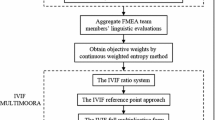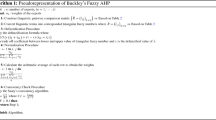Abstract
Failure mode and effects analysis (FMEA) is one of the most effective technique in the field of risk management and is generally preferred to improve process reliability in manufacturing and service sector. Determining the risk priority numbers (RNP) of potential failures is of prime importance for the success of implementing FMEA. The parameters of RNP are generally achieved from experiences and engineering decisions which include uncertainty and vagueness because of the linguistic structure. Fuzzy set theory is preferable approach in order to handle these vagueness in determining the RNP. In this study, single valued neutrosophic Fuzzy FMEA has been firstly developed and it is applied to improve the overhaul process of a fighter jet engine turbine. The proposed model has been tested in an application that analyzes failure modes for maintenance of Low Pressure Turbin (LPT) Rotor Shaft.
Access this chapter
Tax calculation will be finalised at checkout
Purchases are for personal use only
Similar content being viewed by others
References
Stamatis, D.H.: Failure Mode and Effect Analysis: FMEA From Theory to Execution. ASQ Quality Press, Milwaukee (1995)
Xu, K., Tang, L.C., Xie, M., Ho, S.L., Zhu, M.L.: Fuzzy assessment of FMEA for engine systems. Reliab. Eng. Syst. Saf. 75(1), 17–29 (2002)
Guimaraes, A.C.F., Lapa, C.M.F.: Fuzzy FMEA applied to PWR chemical and volume control system. Prog. Nucl. Energy 44(3), 191–213 (2004)
Pillay, A., Wang, J.: Modified failure mode and effects analysis using approximate reasoning. Reliab. Syst. Saf. 79, 69–85 (2003)
Braglia, M., Frosolini, M., Montanan, R.: Fuzzy TOPSIS approach for failure mode, effects and criticality analysis. Qual. Reliab. Eng. Int. 19(5), 425–443 (2003)
Keskin, G.A., Özkan, C.: An alternative evaluation of FMEA: fuzzy ART algorithm. Qual. Reliab. Eng. Int. 25(6), 647–661 (2009)
Chin, K.-S., Chan, A., Yang, J.-B.: Development of a fuzzy FMEA based product design system. Int. J. Adv. Manuf. Technol. 36(7/8), 633–649 (2008)
Abdelgawad, M., Fayek, A.: Risk management in the construction industry using combined fuzzy FMEA and fuzzy AHP. J. Constr. Eng. Manag. 136(9), 1028–1036 (2011)
Hassan, A., Siadat, A., Dantan, J.-Y., Martin, P.: Conceptual process planning–an improvement approach using QFD, FMEA, and ABC methods. Robot. Comput.-Integr. Manuf. 26(4), 392–400 (2010)
Braglia, M., Frosolini, M., Montanari, R.: Fuzzy criticality assessment model for failure modes and effects analysis. Int. J. Qual. Reliab. Manag. 20(4), 503–524 (2003)
Braglia, M., Frosolini, M., Montanari, R.: Fuzzy TOPSIS approach for failure mode, effects and criticality analysis. Int. J. Qual. Reliab. Eng. 19, 425–443 (2003)
Garcia, P.A.A., Schirru, R., Melo, P.F.F.: A fuzzy data envelopment analysis approach for FMEA. Prog. Nucl. Energy 46(3–4), 359–373 (2005)
Zadeh, L.A.: Fuzzy sets. Inf. Control 8, 338–353 (1965)
Atanassov, K.T.: Intuitionistic fuzzy sets. Fuzzy Sets Syst. 20, 87–96 (1986)
Smarandache, F.: A Unifying Field in Logics Neutrosophy: Neutrosophic Probability, Set and Logic. American Research Press, Rehoboth (1999)
Biswas, P., Pramanik, S., Giri, B.: TOPSIS method for multi-attribute group decision-making under single-valued neutrosophic environment. Neural Comput. Appl. 27, 727–737 (2016)
Wang, H., Smarandache, F., Zhang, Y.Q., Sunderraman, R.: Single valued neutrosophic sets. Multispace Multistruct. 4, 410–413 (2010)
Gallego Lupiáñez, F.: Interval neutrosophic sets and topology. Kybernetes 38(3/4), 621–624 (2009)
Hezam, I.M., Abdel-Baset, M., Smarandache, F.: Taylor series approximation to solve neutrosophic multiobjective programming problem. Neutrosophic Sets Syst. 10, 39–46 (2018)
El-Hefenawy, N., Metwally, M.A., Ahmed, Z.M., El-Henawy, I.M.: A review on the applications of neutrosophic sets. J. Comput. Theor. Nanosci. 13, 936–944 (2016)
Deli, I., Subas, Y.: Single valued neutrosophic numbers and their applications to multicriteria decision making problem. Neutrosophic Sets Syst. 2, 1–13 (2014)
Abdel-Baset, M., Hezam, I.M., Smarandache, F.: Neutrosophic goal programming. Neutrosophic Sets Syst. 11, 112–118 (2016)
Abdel-Baseta, M., Changb, V., Gamala, A., Smarandachec, F.: An integrated neutrosophic ANP and VIKOR method for achieving sustainable supplier selection: a case study in importing field. Comput. Ind. 106, 94–110 (2019)
Abdel, S.I., Abd Ellatif, A., Hassan, M.M.: Two ranking methods of single valued triangular neutrosophic numbers to rank and evaluate information systems quality. Neutrosophic Sets Syst. 19, 132 (2018)
Author information
Authors and Affiliations
Corresponding author
Editor information
Editors and Affiliations
Rights and permissions
Copyright information
© 2020 Springer Nature Switzerland AG
About this paper
Cite this paper
Ayber, S., Erginel, N. (2020). Developing the Neutrosophic Fuzzy FMEA Method as Evaluating Risk Assessment Tool. In: Kahraman, C., Cebi, S., Cevik Onar, S., Oztaysi, B., Tolga, A., Sari, I. (eds) Intelligent and Fuzzy Techniques in Big Data Analytics and Decision Making. INFUS 2019. Advances in Intelligent Systems and Computing, vol 1029. Springer, Cham. https://doi.org/10.1007/978-3-030-23756-1_133
Download citation
DOI: https://doi.org/10.1007/978-3-030-23756-1_133
Published:
Publisher Name: Springer, Cham
Print ISBN: 978-3-030-23755-4
Online ISBN: 978-3-030-23756-1
eBook Packages: Intelligent Technologies and RoboticsIntelligent Technologies and Robotics (R0)




